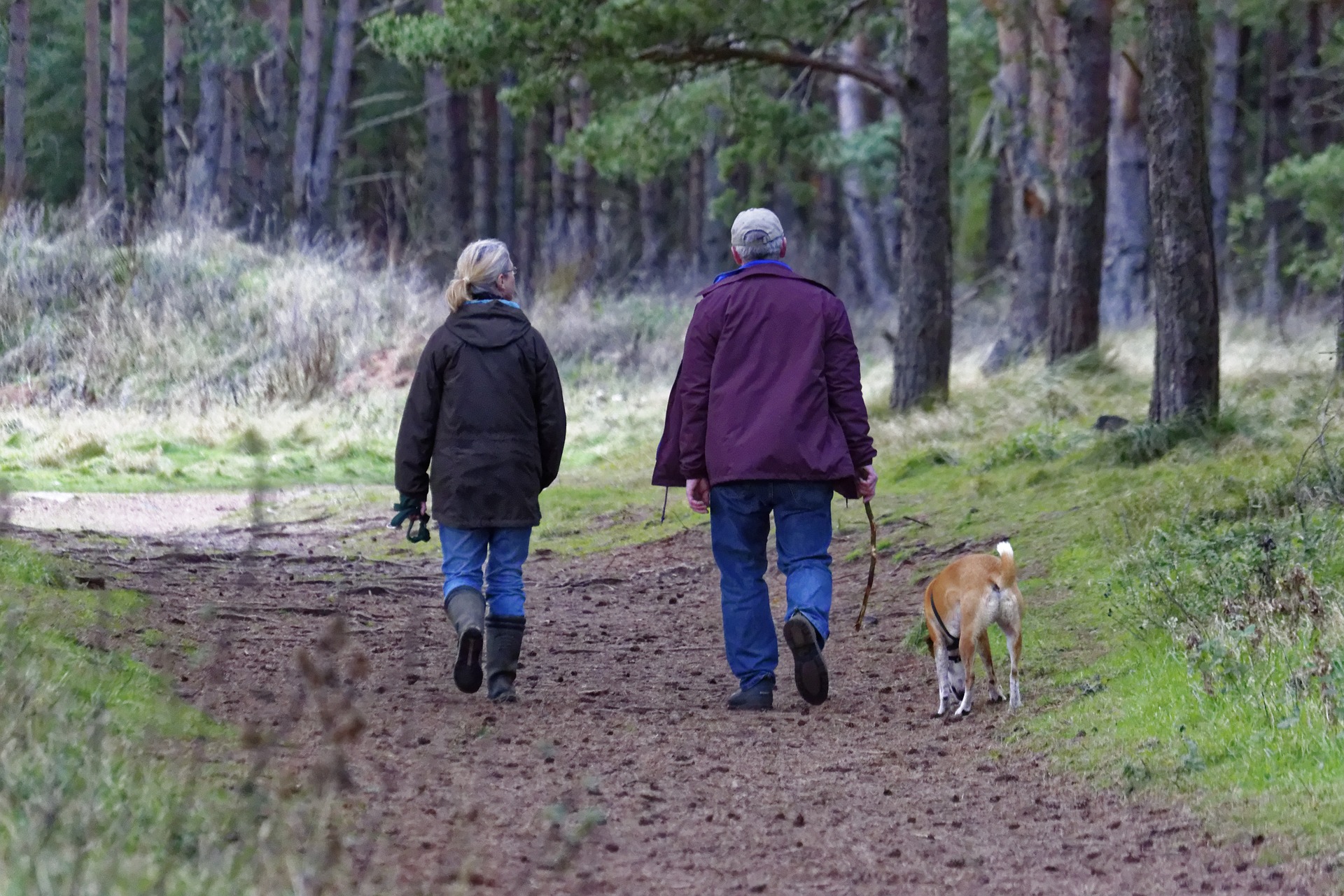
By Marianne Woods Cirone, MS, MFA, CYT-500
In Chicago, spring time means finally getting outside and seeing all the beautiful flowers and plants in bloom. At the cancer center in Geneva where I worked for years, it also meant the life-changing practice of Breathwalk®. A large group of participants — cancer survivors and caregivers — would gather enthusiastically with our amazing Breathwalk® instructor, a physician who led this mindful healing practice. As the instructor began her instructions, the students soon looked transformed. Going from frazzled to calm, they quickly shifted from the flurry of activity in their busy lives to finding the quiet and peaceful center within.
Breathwalk® is a form of mindful exercise from the Kundalini yoga tradition that combines breath, mantra (words), mudra (gestures) and meditation with movement. This walking practice has come from a lineage led by Yogi Bhajan, an important figure in bringing yoga to the West in the 1960s.
The Benefits of Breathwalk®
In practicing Breathwalk®, we combine the three magic ingredients: breath, walking and attention, in order to awaken the mind and body and to release innate stores of vitality. Breathwalk combines the benefits of meditation with movement. Many people feel too fidgety or agitated to sit for a seated meditation practice, or perhaps they have limited time and want to get the benefits of exercise and meditiation. Breathwalk® offers a way to meet those challenges and at the same time provides tremendous support to both physical and mental fitness.
In the book Breathwalk: Breathing Your Way to a Revitalized Body, Mind and Spirit, authors Gurucharan Singh Khalsa and Yogi Bhajan of the 3HO organization describe the many benefits of this practice, including:
- Increased energy – shifting from lethargic and dull to motivated and
- Mood control – shifting from depressed and stressed to calm and clear
- Increased mental focus and clarity of thought – shifting from confused and unfocused to intuitive and directed
- Feelings of connectedness to people, life, nature and ourselves – shifting from our own worries to a sense of being connected and present
Research studies on Breathwalk®, though limited, have found the practice to be beneficial to various patient groups. A study published in the World Journal of Gastroenterology in 2007 concluded that “Breathwalk has an important effect on body composition, lipid profile and liver enzymes. It is also easy, inexpensive and has a beneficial effect on metabolic and mood state in HCV [hepatitis C virus] patients.”
A University of Utah study found that “Significantly greater improvements in the primary outcomes of pain, fatigue, and restful sleep were found following eight weeks of breathwalk activity for one hour twice a week compared to regular exercise walking.”
Breathwalk for Cancer Survivors and Patients
Can Breathwalk® benefit cancer patients and survivors? In their book, The Cancer Recovery Plan: Maximize Your Cancer Treatment with this Proven Nutrition, Exercise and Stress Reduction Program, D. Barry Boyd, M.D and Marian Betancourt recommend Breathwalk® for people going through cancer treatment and beyond. Dr. Boyd, a medical oncologist who founded the Integrative Medicine Program at Greenwich Hospital-Yale Health Systems in 1998, is a pioneer in integrative cancer care. In The Cancer Recovery Plan, the authors describe the benefits of Breathwalk®:
“With practice, combing the rhythmic cadence of walking with the conscious pattern of breathing provides a profound experience, capable of generating the relaxation response described first by Herbert Benson, MD, as central to the physiologic benefits of most meditative techniques. In addition, it simultaneously provides the well-described metabolic benefits of brisk walking.”
How Does the Breathwalk® Technique Work?
The Breathwalk® practice combines the process of walking and fully conscious breathing with the mantra (a repeated word or phrase): Sa, Ta, Na, Ma. Those four syllables, which are chanted mentally in this practice, respectively mean birth, life, death and rebirth.
According to Yogi Bhajan, the mantra works as follows: Sa evokes a feeling of expansiveness; Ta creates a feeling of strength and transformation; Na creates a sense of universal love and Ma evokes the quality of communicativeness. The mudras, or hand gestures, that are used here reinforce and expand the qualities that build strength and consciousness.
Practicing Breathwalk is relatively simple, but the mental, emotional, spiritual and physical benefits may be immense. You can invest in a book, such as Breathwalk: Breathing Your Way to a Revitalized Body, Mind and Spirit, by authors Gurucharan Singh Khalsa and Yogi Bhajan, or Breathwalk: Illustrated Program Guide.
Shakta Kaur, a kundalini yoga instructor in Chicago, offers a Breathwalk® Intensive Training, as a Personal Intensive (one weekend) or as an Instructor Training (two weekends). Shakta Kaur cites the book, How God Changes Your Brain: Breakthrough Findings from a Leading Neuroscientist, as verifying the mantra ‘Sa Ta Na Ma,’ (one of the mantras used in Breathwalk®), clearly that demonstrating that neural patterns and mental functioning are enhanced by the use of this mantra.
If you would like to try practicing on your own or in a group, you can use the basic directions found below:
To Begin the Breathwalk® Practice
- Start with some simple grounding practices:
- Stand tall, grounding yourself into the earth.
- Breathe fully with a soft belly. Place one hand on the abdomen, feeling the breath move into the belly.
- Feel your breath moving into all parts of your lungs. Breathe fully, feeling the lungs fill with space. Exhale and breathe in again, filling your lungs with energy. Breathe again, filling your lungs with peace.
- Next, continue by walking outside in safe spot in nature (ideally), moving at a comfortable pace, simply observing the sensations in your body
- Feel your feet on the ground
- Feel the air on your skin
- Feel your body moving in space
- Pay attention to all the adjustments that occur as your keep your balance
- Now, observe your breath
- How loud and long is the breath?
- Where do you feel it originating?
- Can you make it quieter and smoother?
- Next, coordinate your breath with your stride, breathing through the nostrils:
- Inhale for 4 steps, filling the lungs ¼ more with each inhalation.
- Exhale for 4 steps, contracting the abdominal muscles and the navel in toward the spine.
- Continue to observe this process as you walk.
- Have a timer ready to use to time the steps of the Breathwalk® practice.
- Next, add the mudra, or hand movement, by touching your thumb to your fingers one at a time, starting with the index finger. At the same time, add the mantra Sa Ta Na Ma, chanting it silently to yourself as you walk, breathe and move your fingers. This may take some concentration, especially at the beginning. (Be careful not to trip or get lost).
- Continue walking in this rhythm for 8 minutes, being very aware of all sensations. Notice what you are feeling, what you are hearing, what you are seeing, any scents in the air. If you are in group, you will walk in silence, only repeating the mantra silently to yourselves.
- Notice what you notice. Notice what surprises you, what interests you. Notice: is your heart lighter? Do you feel gratitude? Focus on this moment in time. See what you have never seen before.
- After 8 minutes, resume normal walking for 5-8 minutes. If you are in a group, you can chat amongst yourselves until the next time segment.
- Repeat the Breathwalk® process again. You can continue this back and forth for up to an hour… remembering to stop if you feel dizzy, lightheaded, or have other discomfort.
- At the completion of the walk, take a bit of time to stretch out, moving the arms, neck, shoulders, etc. Notice how it feels to stop moving. Feel the weight of the body move back into the earth and get grounded again.
- Move into mountain pose and close your eyes. Visualize the most majestic and beautiful mountain that you have ever seen. Next, visualize yourself as that mountain: strong and steady, firm and unwavering. Feel the beauty, power and strength within yourself. Take this strength with you through the rest of your day, returning to it often.
- You can share your experiences of the walk, or perhaps spend some time journaling about what you saw and felt. The time taken to assimilate and process this experience will deepen the practice and will likely prove to be a wise investment on the proverbial road to inner peace. And remember, keep walking! The benefits will accrue with the practice.



















